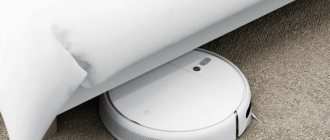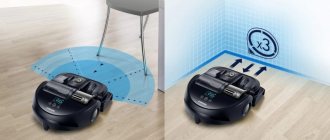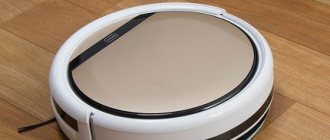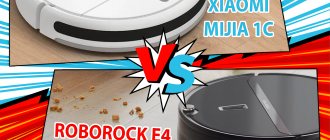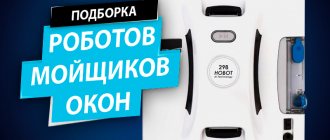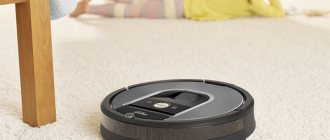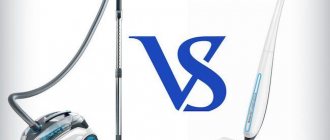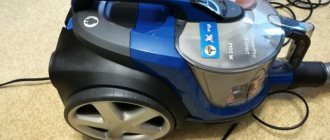Polaris robot vacuum cleaners are smart technology with an impressive range of useful functions.
The popularity of the devices is due to their reliability, ability to perform all assigned tasks, and affordable price.
The manufacturer offers several lines from which you can choose a multifunctional unit with an excellent price-quality ratio.
What features do Polaris robot vacuum cleaners have and which models are in high demand are discussed in this article.
Rating of the TOP 7 best Polaris robot vacuum cleaners of 2021
| Place | Name | Price |
| TOP 3 best Polaris robot vacuum cleaners with dry cleaning | ||
| 1 | Polaris PVCR 0726W | Find out the price |
| 2 | Polaris PVCR 0316D | Find out the price |
| 3 | Polaris PVCR 1012U | Find out the price |
| TOP 4 best Polaris robot vacuum cleaners with dry and wet cleaning | ||
| 1 | Polaris PVCR 0826 | Find out the price |
| 2 | Polaris PVCR 0926W EVO | Find out the price |
| 3 | Polaris PVCR 0920WV | Find out the price |
| 4 | Polaris PVCR 0930 SmartGo | Find out the price |
Top best Polaris models
The Polaris company offers a large number of vacuum cleaners for automatic room cleaning. The most popular models: PVCR 0726W, 0920WV Rufer, PVCR 0826, PVCR 1012U, PVCR 0926W EVO.
PVCR 0726W
The Polaris robot vacuum cleaner has a beautiful appearance. Its surface is glass.
The wet vacuum cleaner is multifunctional. In addition to dry cleaning surfaces from dust and debris, it can also collect spilled liquid.
The washing device has the following characteristics:
- battery life - 3.5 hours;
- battery - lithium-ion;
- good orientation in space due to infrared sensors;
- anti-fall sensors installed;
- moves silently;
- suction power - 25 W;
- bagless dust collector, container holds 500 ml;
- control of buttons on the case and remote control;
- The height of the vacuum cleaner is 76 mm, so it can pass under low furniture.
The kit includes a water container, a microfiber cloth, a turbo brush and side nozzles.
The disadvantages include the rather high cost.
In addition, it has been established that if there is a black stripe on the floor, the device considers it as an obstacle. No data about the battery status is written anywhere yet. The next disadvantage is that it is not possible to install a virtual wall.
0920WV Rufer
The Polaris robot vacuum cleaner is a fully automated device, and the price is reasonable compared to other models from competitors. The advantage is the ability to carry out not only dry cleaning, but also wet cleaning.
Other features of the model are as follows:
- suction power - 25 W;
- a 500 ml cyclone filter is used;
- control is carried out using buttons on the case and a remote control;
- battery - lithium-ion;
- Autonomous operation - 1 hour 40 minutes, which is enough to clean 45 sq.m.;
- recharging takes 5 hours;
- a built-in liquid crystal display on which you can see the time and battery status, there is an option to notify data by voice;
- the ability to install a virtual wall;
- There are 5 movement patterns for the vacuum cleaner, including automatic mode and cleaning near walls.
The kit includes 2 cleaning blocks, including an electric brush, a nozzle with a napkin, and a water container. Among the shortcomings, they indicate that the robot does not move around objects well. Parking at the base is also not always accurate.
PVCR 0826
This Polaris robot vacuum cleaner also performs dry and wet cleaning. The features of the model are as follows:
- the body is made in pale pink tones with gray details;
- made a rubberized bumper;
- garbage container is designed for 500 ml;
- battery - lithium-ion;
- Autonomous operation - 200 minutes;
- recharging - 5 hours, and you can use a docking station or charger;
- automatic return to base at critical charge level;
- presence of 5 operating modes;
- ability to program the device;
- built-in indicator that lights up when the dust container is full;
- height and obstacle sensors;
- device weight - 3.5 kg;
- noise level - 60 dB;
- height - 76 mm, so it can pass under low furniture;
- power consumption - 25 W;
- suction power - 22 W.
One of the disadvantages is the need to replace the container when changing the cleaning regime. The second disadvantage is that you need to recharge the device only after the battery has completely used up its energy. Moreover, this must be done at least once every 3 months so that it does not deteriorate.
PVCR 1012U
This model is intended for dry cleaning. It is made in black and gray shades. Has a stylish appearance.
The device is easy to operate. The main characteristics are as follows:
- height - 7 cm;
- weight - 1.5 kg;
- suction power - 18 W;
- battery - lithium-ion;
- Autonomous operation - up to 100 minutes;
- recharging - up to 4 hours;
- The dust container has a capacity of 300 ml;
- noise level - 60 dB.
One of the disadvantages is the lack of a remote control. The start button is located at the bottom, not on the top panel. There is no charging station, so you will need to connect the vacuum cleaner yourself. Another drawback is the small volume of the garbage compartment.
PVCR 0926W EVO
This Polaris robot vacuum cleaner has an attractive appearance and sufficient technical characteristics for high-quality room cleaning. The price is in the average category on the market.
The device is small in size, so it can pass under low furniture. There is a bumper on the body to protect against impacts. There is no display. On the bottom there is space for the main turbo brush and 2 additional side attachments for connecting a cloth.
This robotic vacuum cleaner handles dry and wet cleaning. There are several modes of operation: cleaning the required area, moving in a spiral, along the walls, and also automatic.
A remote control is provided for remote control. Autonomous operation lasts 3 hours 20 minutes. Then it requires recharging, which lasts 5 hours. The disadvantages include the inability to make maps of the room and install a virtual wall.
Types of devices
The company produces three types of this equipment:
- With dry cleaning . The devices are equipped with cyclone suction technology. The tube is located in the center of the lower housing. Moving along the floor, the vacuum cleaner collects debris with side brushes and directs it into the tube. But this technique requires systematic cleaning or replacement of the filter. Otherwise, performance will be reduced to a minimum.
- With wet cleaning . The equipment is equipped with infrared sensors that recognize the height and objects in the room. The first models had random navigation, so they broke down quickly. Modern ones are able to draw up a room plan and save a map in memory. The design includes a water tank. As the vacuum cleaner moves, it scatters liquid over the surface and then wipes it with a built-in cloth.
- With dry and wet cleaning . These are combined models with 2 tanks - for water and garbage. Equipped with side brushes, an electric brush, and a damp cloth. At the beginning of cleaning, the robot sucks up all the debris and then wipes the floor with a damp cloth. They are endowed with various functions - from a timer to working in a smart home system. But this technique is an expensive product.
How to choose and what to pay attention to?
The tips are as follows:
- Decide on the type of device . Here you should decide for what purposes the equipment will be used. If there are a lot of carpets in the house, then it is better to choose a wet vacuum cleaner. If you want to experience innovative technologies, it is recommended to give preference to combined models. If everyday wet cleaning is necessary, then it is enough to buy a washing vacuum cleaner.
- Pay attention to the navigation system . The type of technology affects the quality of the device’s orientation in space. More expensive models are able to scan and remember the location of objects in the room. Budget options are equipped with internal sensors, but they do not boast of flawlessness.
- Consider the volume of tanks . So for a small room, the best option would be a model with a container capacity for garbage of up to 0.50 liters, and for water - up to 1 liter.
- Is it possible to program the functions ? Modern robot vacuum cleaners easily “accustom” to a cleaning schedule. It is enough to include in the program the exact days of the week and their number. The device will clean the room on its own and then return to its base to recharge.
Below is an overview of popular models from Polaris with detailed characteristics, advantages and disadvantages.
The best Polaris robot vacuum cleaners with dry cleaning
Polaris PVCR 0726W
The model is distinguished by a small round light body and the presence of two side brushes that improve the quality of cleaning..
The vacuum cleaner is capable of operating in automatic mode - it cleans the floor perfectly, changes the movement algorithm, and returns to the base.
The user can personally control the robot - turn on the intensive cleaning mode of the area, the cleaning mode along the walls, or program it for daily cleaning at a specific time.
It is worth noting that this is one of the best models of 2021.
Characteristics:
- dust container volume - 0.50 l;
- there is a HEPA 12 fine filter;
- power - 25 W;
- noise level - 60 dB;
- battery type - Li-lon, operating time - up to 200 minutes;
- sensor class - infrared, movement - along the wall;
- number of driving modes - 5;
- complete with electric brush and side brush;
- features - liquid collection, 5 cleaning modes including local, timer, remote control, soft bumper;
- dimensions - 31x31x7.60 cm.
pros
- automatic return to the charging block;
- alarm about getting into a difficult situation;
- suitable for light wet cleaning;
- spacious trash container;
- long battery life;
- compact dimensions;
- attractive design;
- easy control using an ergonomic remote control.
Minuses
- no display;
- does not see wires in the room;
- poor spatial orientation.
Polaris PVCR 0316D
This model is designed only for dry cleaning with effective penetration into hard-to-reach areas of the apartment.
Excellent collection of dust, wool and debris. Equipped with infrared sensors to study the room.
Cleaning occurs automatically.
The HEPA 12 fine filter has antibacterial properties, so the vacuum cleaner additionally cleans the apartment of germs and tiny parasites.
The collected garbage is placed in a special container - it is easy to clean.
Characteristics:
- container volume - 0.60 l;
- power - 25 W, suction - 23 W;
- battery class - Ni-MH, operating time - up to 45 minutes;
- sensor type - infrared, movement - zigzag, along the wall;
- complete with electric brush and side brushes;
- functions - 6 cleaning modes, time limit, local cleaning, built-in clock, timer, display, soft bumper;
- dimensions - 31x31x8.20 cm.
pros
- competent movement algorithm;
- high-quality cleaning;
- operating time without recharging;
- good orientation even in the presence of a huge number of obstacles;
- almost silent operation;
- affordable price;
- compactness and lightness.
Minuses
- does not suck up large debris;
- no self-charging.
Polaris PVCR 1012U
The robot vacuum cleaner performs dry cleaning on hard surfaces - laminate, linoleum, parquet, wood, etc..
Side brushes help to collect debris towards the center of the lower body and draw it in with the air flow.
Thanks to its compact size, the device fits easily under low furniture.
This is a budget model with standard functions, motion trajectories specified by the manufacturer.
Characteristics:
- dust tank volume - 0.30 l;
- suction power - 18 W;
- noise level - 60 dB;
- battery type - Li-lon, operating time - up to 100 minutes;
- sensor class - ultrasonic;
- number of modes - 3;
- complete with side brush;
- features: soft bumper.
pros
- fast recharging from a regular network;
- simple control using buttons on the body;
- affordable price;
- interesting design in the form of a drop;
- simple design;
- there is nothing superfluous.
Minuses
- small container volume;
- unable to clean corners;
- no base or remote control;
- weak power.
Review of Polaris PVCR 0726W. Robot vacuum cleaner with wet cleaning
Robot vacuum cleaners are no longer exotic; now the choice in Russian stores is varied and large. From top models to inexpensive ones. From famous brands to Chinese ephemera. From stuffed with sensors and electronics to stupid models. And lo and behold! Some of them really know how to clean an apartment, and not just entertain children and cats. However, as is usually the case, the key to success does not always directly depend on cost. It is not necessary to spend 40,000 - 60,000 rubles to purchase such an assistant; there are also quite affordable options comparable in cost to conventional vacuum cleaners.
The Polaris PVCR 0726W robot appeared in our editorial office at the beginning of last month; we had time to study it in detail and gain operating experience in an ordinary apartment. Below in the summary table, compiled on the basis of the Yandex.Market service, you can see the prices.
Polaris PVCR 0726W review
Equipment
Polaris PVCR 0726W is supplied in a package with bright printing. Detailed technical characteristics of the robot vacuum cleaner are provided.
I was pleased with the package, it includes: a charging dock, a power supply, HEPA filters, spare brushes, a mop cloth, a water block, an air block, a cleaning brush, a control panel, instructions and a warranty card.
Appearance
Polaris PVCR 0726W makes a good impression. Fits harmoniously into the interior of an expensive and ordinary apartment. Here they did not go overboard with decorative elements.
High-quality assembly, nothing loose or loose. All external surfaces of the vacuum cleaner are easy to maintain. The chassis consists of two large wheels with active suspension. They allow the vacuum cleaner to lean all 3.3 kg of its weight on a surface with a difference in height; it can independently climb onto carpets with large piles.
In addition to them, there is a small swivel wheel closer to the front side, which serves as a support. Polaris PVCR 0726W can rotate almost in one place.
The side three-bladed brushes are fixed with screws. The protruding pile rakes debris well from corners and hidden surfaces. The right and left brushes are marked, and the kit includes spare ones.
These brushes sweep dust and debris towards the suction port. This waste is then picked up by the main electric brush. Due to the rubberized stopper, even the smallest particles are not missed.
The dust collector is fixed in the back. The user can choose between two options. The main one is needed for everyday cleaning; its volume is 0.6 liters. It snaps securely and does not wobble while driving.
In addition to it there is a water tank, onto which the mop cloth is attached using rubber bands.
The bottom surface of the Polaris PVCR 0726W has three infrared sensors to prevent falls.
One of the features worth noting is the low height of the case, only 7.6 cm. It fits under beds, cabinets and refrigerators without any problems.
The powered lithium-ion battery is hidden in a compartment between the front brushes. A full charge is enough for 3.5 hours of work or cleaning an apartment of 170 square meters.
You can charge the Polaris PVCR 0726W from the docking station or directly by connecting the adapter to the vacuum cleaner body.
Tests and work
Polaris PVCR 0726W uses a vacuum cleaner, sucking up everything that comes from the side brushes. Large particles are swept into the container by the main brush. The body is stuffed with mechanical and optical sensors, they allow you to clearly detect obstacles and walls. Hard contact with obstacles was not noticed during the entire lengthy tests. There is protection against falls from stairs or ledges, all these sensors work well. This work was tested by placing it on a table.
It is claimed to overcome thresholds up to 15 mm high at an angle of up to 15 degrees. If the obstacle is not overcome on the first pass, the robot moves back and attacks the obstacle again.
No screens or unnecessary illumination were placed here.
There is only one active element - a backlit mechanical button on the lid. Plus, problematic situations are duplicated with a sound alert. The system has several operating modes. The simplest is to completely clean the room; it lasts for 3 hours. There is a short cleaning mode with a duration of 30 minutes. The owner himself has the opportunity to set the time to start cleaning and every day Polaris PVCR 0726W will go out to clean the premises.
Wet cleaning deserves special attention. There are not many models with a similar system on the market. We carried out such cleaning once every 3-4 days. The process is very simple: water is poured into a separate container to measure. That's it, the robot does the rest of the work, and the water flows evenly onto the mop. 30 minutes of such trips replace wet cleaning of the house.
All these modes are carried out against a background of low noise levels. During active operation, the noise does not exceed 55 dB. After a few days, you completely stop noticing the work of the Polaris PVCR 0726W, the apartment is cleaned without attracting attention.
The robot vacuum cleaner can suck up even fine dirt scattered on the carpet, which is beyond the power of conventional vacuum cleaners. He copes with most tasks perfectly. This is especially noticeable after the first cleaning cycles; a full container of dirt collects.
Maintenance is simple; the owner is required, depending on the amount of dirt collected, to remove and empty the contents of the container. In the future, you may need to clean the brushes and antibacterial filter.
But there are some nuances that will require changing habits. The first of them concerns scattered extension cords, smartphone chargers and ribbons. They are likely to get wrapped around the brushes.
The second is related to the low height of the case; in our case, it climbed under one of the refrigerators, where it happily got stuck. The same problems can occur with cabinets with a lower plane to the floor at a level of 8-9 cm; you will need to think through and create an obstacle. Such places will be localized after several cleanings, everything can be solved, the robot itself simply turns off when it gets into a dead end situation.
Results for Polaris PVCR 0726W
We really liked the Polaris PVCR 0726W. A really useful gadget for everyday apartment cleaning. Smart and persistent, it demonstrated high quality cleaning and easy operation. It clearly obeys the remote control and independently finds the charging dock. Definitely worth the money.
The best Polaris robot vacuum cleaners with dry and wet cleaning
Polaris PVCR 0826
The model perfectly cleans any floor surfaces without human intervention . Equipped with two reservoirs - for water and garbage.
One filling of liquid lasts for 30 minutes when using a short program.
Cyclonic technology maintains constant suction power, but the motor operates in a gentle mode.
The combination of engineering technologies allows us to obtain a high-tech device to solve the assigned problems.
Characteristics:
- dust tank volume - 0.50 l;
- there is a fine filter, automatic wetting of the cloth;
- suction power - 22 W;
- noise level - 60 dB;
- battery type - Li-lon, operating time - up to 200 minutes;
- sensor class - infrared;
- type of movement - along the wall, number of modes - 5;
- complete with electric brush and side brush;
- functions - local cleaning, built-in clock, timer, control panel, soft bumper;
- dimensions - 31x31x7.60 cm.
pros
- automatic return to base;
- alarm when jammed;
- compact dimensions;
- quiet operation;
- productive battery;
- excellent suction of any debris;
- after the wet cleaning function, the floors shine;
- Suitable for cleaning carpets.
Minuses
- no programming;
- poor filter quality.
Polaris PVCR 0926W EVO
An expensive model that stands out for its high quality cleaning and wide functionality . Great for cleaning any floor surfaces, fleecy carpets.
Control occurs manually or automatically.
Highly sensitive sensors help the device scan and navigate in space.
Large dust container allows you to perform multiple cleanings without cleaning the filter.
The water tank consumes liquid evenly and does not require regular refilling.
This is one of the highest quality models for 2021.
Characteristics:
- suction power - 22 W;
- noise level - 60 dB;
- battery type - Li-lon, operating time - up to 200 minutes;
- sensor class - infrared;
- type of movement - along the wall, number of modes - 5;
- complete with electric brush and side brushes;
- features - local cleaning, timer, control panel, soft bumper;
- weight - 31x31x7.60 cm.
pros
- automatic return to base;
- fine filter;
- sensors detect heights and differences;
- long work without recharging;
- wet cleaning without the use of detergents;
- selection of movement type;
- high build quality.
Minuses
- high price;
- long recharging;
- sensitivity to thresholds.
Polaris PVCR 0920WV
A popular model for high-quality cleaning of floors made of any material, fleecy and smooth carpets.
The uniqueness lies in the presence of a cleaning zone limiter - a virtual wall.
It helps the vacuum cleaner divide the room into zones without leaving it while cleaning.
Also, the virtual wall limits the robot’s movement if there are fragile or valuable things in the room.
Characteristics:
- dust container volume - 0.50 l;
- there is a fine filter;
- suction power - 25 W;
- battery type - Li-lon, operating time - up to 100 minutes;
- type of movement - zigzag, along the wall;
- complete with electric brush and side brush;
- functions - built-in clock, timer, display, control panel, soft bumper;
- dimensions - 34.50x34.50x8.50 cm.
pros
- automatic return to base;
- building a virtual wall;
- high quality as dry cleaning;
- The container volume is enough for 4 cleanings;
- ability to set a schedule;
- does not turn on without containers.
Minuses
- the specified movement algorithm does not match;
- terrible wet cleaning;
- does not always find the base.
Polaris PVCR 0930 SmartGo
A worthy model in its class. Endowed with unique capabilities that include the elimination of falls from a height, intelligent water consumption using SmartDrop technology .
The IQ-Action inverter motor consumes a minimum of electricity, but helps the vacuum cleaner do its job perfectly.
Cleaning happens faster without human intervention.
Characteristics:
- tank volume for dust - 0.20 l, for water - 0.30 l;
- there is a fine filter;
- power - 25 W;
- noise level - 60 dB;
- battery type - Li-lon;
- type of movement - in a spiral, along the wall;
- complete with side brush;
- functionality - 8 modes, built-in clock, programming, timer, display, control panel, soft bumper;
- dimensions - 31x31x7.60 cm.
pros
- building a map of the premises;
- automatic installation on the base;
- alarm when jammed;
- excellent movement, according to a given algorithm;
- simple controls;
- high build quality;
- the price corresponds to the capabilities.
Minuses
- No
Rating updated September 12, 2021.
Robot vacuum cleaner Polaris PVCR 0726W: dry and wet cleaning
This robot is distinguished by a round, light body of small height and the presence of two side brushes that improve the quality of cleaning. In automatic mode, Polaris PVCR 0726W retracts, changing the movement algorithm, and returns to the base to charge the battery. In addition, the user can manually control the movement of the robot, turn on the intensive cleaning mode of a local area or the mode of following along the walls, and the robot can also be programmed to clean daily at a given time.
Content:
- Video review
- Specifications, delivery set and price
- Appearance and function
- Testing
- conclusions
Video review
To get started, we suggest watching our video review of the Polaris PVCR 0726W robot vacuum cleaner:
You can also watch our video review of the Polaris PVCR 0726W robot vacuum cleaner on iXBT.Video
Now let's take a look at the specifications of the device.
Specifications, delivery set and price
| Kinematic system | Two drive wheels and a support swivel roller |
| Dust collection method | Inertial movement and vacuum filtration |
| Dust collector | One compartment, capacity 0.5 l |
| Main brush | One with lint |
| Side brushes | Two |
| Additionally | Rubber scraper |
| Cleaning modes | Automatic until battery discharges, cleaning 30 minutes, local, along obstacles, manual, scheduled |
| Noise level | No data |
| Obstacle sensors | Mechanical front/side bumper, IR proximity and height difference sensors |
| Orientation sensors | IR base search sensors |
| Controls on the body | Mechanical button |
| Remote control | IR remote control |
| Alert | LED indicator and sound signals |
| Battery life | up to 200 min. |
| Charging time | up to 5 hours |
| Charging method | On a charging base with automatic return or directly from the power supply |
| Power supply | Li-ion battery, 14.8 V, 2600 mAh, 38.5 Wh |
| Power | 25 W |
| Weight | No data |
| Dimensions (diameter×height) | ∅310×76 mm |
| Contents of delivery |
|
| Link to manufacturer's website | www.polaris.ru |
| Average price according to Yandex.Market | T-13625419 |
| Offers based on Yandex.Market data | L-13625419-10 |
Appearance and function
The Polaris PVCR 0726W robot vacuum cleaner is packaged in a colorfully decorated cardboard box with a calm white background.
The box has typical dimensions for such devices. It is equipped with a plastic handle, so it will not be difficult to carry your purchase home. The delivery set includes almost all the accessories necessary for the robot to operate, and only AAA batteries for the remote control will have to be purchased.
Spare parts and consumables included in the package include a replaceable folded filter of the last stage, a set (right and left) of side brushes and two cloths (apparently made of microfiber) for wet cleaning. There is also a combination brush-comb that can be used to clean the dust collector, the robot itself, and the main brush in particular. The user manual is a booklet of several pages. The manual is, of course, in Russian. The quality of text and printing is quite high. A PDF version of the manual can be downloaded from the Polaris website.
The robot body is made of two types of plastic - black (bottom) and white (top) with a matte surface. The option is non-staining, and the predominantly light color of the body makes it easier to find the robot in the dark corners of the apartment when for some reason it does not return to base; it is also easier to notice the robot with peripheral vision when it gets underfoot, which means it is less likely to be attacked come on. The upper part of the body is covered with a thick plate of transparent and relatively damage-resistant plastic. Under the plate there is a golden-colored coating. On the top panel towards the front there is a single mechanical button with the word Auto and a power icon illuminated.
Depending on the current status, this indicator glows solid green or flashes orange (charging) or red (error). The brightness of the indicator is moderate, and since the button coating is silver and reflects everything, it is sometimes difficult to see in the light what kind of condition it is. Additionally, the robot informs about its condition using short and not very loud sound signals. You cannot turn off the sound notification. The vacuum cleaner has an almost perfectly round shape with a diameter of 306 mm (hereinafter in the text the results of our measurements are given). The bottom edges are beveled, which helps the robot overcome obstacles, and some angularity in the transition from the top panel to the side surface and a lip on the bumper at the top reduce the likelihood that the vacuum cleaner will get stuck under obstacles with little clearance.
The robot's mass is 2.6 kg. The axes of the driving wheels are located on the same diameter of the body circumference, this allows the robot to turn on the spot without changing the boundaries of the area it occupies. A positive role is played by the relatively small height of 77 mm (along the side of the bumper) and the body, which is smooth around the perimeter. The drive wheels with a diameter of 65 mm are equipped with grippy rubber tires with pronounced lugs. The wheels are mounted on spring-loaded joints with a travel of 27 mm, which also improves the robot's ability to overcome obstacles. True, the lower part of the bumper is at a height of 17 mm from the floor - the robot cannot overcome obstacles higher. A spring-loaded bumper with a small stroke goes around the entire front half of the body.
Shifting the bumper triggers mechanical obstacle sensors. To protect furniture from the front, a strip of medium-hard rubber is glued to the lower part of the bumper. Higher up on the bumper behind a tinted plastic window are IR obstacle detection sensors, a base station and, possibly, a command receiver from the remote control. Some of the above are apparently also located behind the tinted windows on the body behind the bumper closer to the back of the vacuum cleaner. By pressing the latch at the back, you can detach the dust collector from the robot body.
The body of the dust collector is made of tinted transparent plastic, but this does not bring much benefit, since you can only see something in the dust collector either by turning the vacuum cleaner upside down or by removing the dust collector. The front partition in the dust collector is of sufficient height so that when carefully manipulating it, debris does not fall out of the closed dust collector. The upper part of the dust container tilts to a large angle, which makes it easy to shake out heavy debris from the lower part. For complete cleaning, remove the pre-screen filter, shake off any light debris, and clean the foam filter and pleated fine filter if necessary.
It is convenient to perform these operations, as well as empty the dust container, using a conventional vacuum cleaner with a crevice nozzle. Just be careful not to suck in the thin foam filter. From our point of view, such a multi-stage filtration system is redundant and only reduces the air flow; one mesh filter would be enough. In any case, foam rubber is definitely superfluous. However, during the tests, a lot of light debris was collected on the first filter (and this was from a clean floor), which means that the suction power, even with all the filters, is relatively high. Note that there is no fan in the dust collector itself, so the dust collector and filters can be washed under water, the main thing is to dry everything well afterwards. It is recommended to change the folded fine filter after 6 months of use. The side brushes have long and stiff bristles, tufts of which emerge from elastic leads. Let us remind you that side brushes that have lost their shape can be straightened by smoothing out the tufts of bristles under hot water and drying the brushes before installing them in place. The right and left brushes differ in the rotation of the leads, and so that the user knows which one to install where, the letters L
and
R.
_ The brushes are attached to the drive axis using a self-tapping screw with a Phillips head screwdriver. The shaft of the main brush is smooth, of relatively large diameter and with longitudinal grooves - this makes it easier to free the shaft simply with your fingers without the help of tools from threads, hair and other things that have been wound up. The bristles on this brush are of medium hardness, and their tufts are wavy, which reduces the sound from the rotation of the brush in contact with the floor. The steel axis at the end of the brush rotates in a sliding bearing in the form of a bronze bushing. This is the right design decision, since the rolling bearings in this unit sooner or later jam due to hair, wool, etc., wrapped around the cage. The brush in the compartment is fixed with a yellow plastic frame. This frame has a rubber scraper that helps the brush pick up debris from the floor and throw it into the dust bin.
Note that the drive gears of the brushes and wheels allow them to be rotated by hand; this is very helpful when you need to pull the robot out, for example, from under a sofa under which it is stuck, or to untangle something wrapped around the wheels or brushes. When cleaning, the front side brushes scoop up debris to the center, then the main brush throws debris into the dust bin, and the air flow helps suck the lightest debris into the dust bin. Elastic gaskets along the entire path from the inlet of the dust collector to the fan eliminate parasitic air suction past the filters and dust collector.
For wet cleaning of smooth floors, instead of a regular dust collector, you can install the special container included in the delivery package. A terry cloth is attached to the bottom of the container with Velcro and two elastic bands.
The napkin can be pre-moistened, and to keep it moist, you need to pour water or a detergent solution into the container reservoir.
The liquid seeps onto the napkin through porous inserts in the bottom of the tank. This container also has a small compartment for garbage, where the main brush throws it, however, the fan is no longer involved in collecting garbage, since the inlet pipe is blocked by the wall of the container.
On the right side there is a power connector for direct charging of the battery and a button that disconnects the battery from the robot circuits.
This robot has a lithium-ion battery. The battery pack is made up of four cylindrical cells of the popular 18650 size.
On the bottom there are two contact pads, a front support swivel roller, side brushes, a battery compartment cover, two drive wheels, and a main brush compartment. Closer to the edge, just behind the bumper, there are three IR height difference sensors, thanks to which the robot vacuum cleaner can avoid falling down the steps.
Note that this robot worked without problems on a black carpet, while in most other robots the height difference sensors had to be deactivated so that the robots did not consider the black floor to be a failure into nowhere. The front roller is made of black elastic plastic alternating with white and hard. This was done for a reason, but so that the robot, using an optical sensor located under the roller, could determine whether it is moving during cleaning or not, that is, stuck. However, during testing, we did not find any reliable signs that information about the rotation of the video is being used in any way.
The base on which the vacuum cleaner is charged has a relatively large base, onto which four anti-slip rubber feet are glued to the bottom.
The base is powered by an external power adapter, which can also be used to charge the robot, bypassing the base if for some reason it is unavailable.
The vacuum cleaner comes with a small IR remote control.
The remote control buttons are made of elastic rubber-like material; the markings on the buttons are quite large and contrasting. The screen on the front of the remote control shows the current time and the time at which cleaning is scheduled to start automatically.
The Polaris PVCR 0726W robot vacuum cleaner has five cleaning modes:
Auto mode
until the battery is almost completely discharged, while the robot moves in a straight line from obstacle to obstacle, randomly changing direction after a collision, and follows the walls for some time. These options are cycled through. This mode is activated by pressing the Clean button on the remote control or the Auto button on the robot itself. This mode is also used during scheduled cleaning. Having completed cleaning, the robot returns to the base to charge the battery.
Automatic cleaning, but limited to 30 minutes
It is turned on by double pressing the Clean button on the remote control or the Auto button on the robot itself. Looking ahead, we note that we were unable to enable this mode.
In manual mode
When cleaning, the direction of movement of the robot is set using the buttons on the remote control. If you first start the robot for cleaning in automatic mode, the robot turns in place at a fixed angle when you press the right-left arrows on the remote control, turns around when you press the down arrow, but cleans and continues to move straight even after the button is released. If you do not start the robot to clean, it stops after the maneuver and moves forward until it collides with an obstacle after pressing the forward arrow, cleaning in motion.
For intensive cleaning
To reach a certain place, you need to move the robot there or direct it to the desired place in manual control mode, and then press the button with the spiral icon on the remote control. The robot will begin cleaning in an unfolding and then collapsing spiral in a circle approximately one meter in diameter.
Another cleaning option is to move only along walls and obstacles. This mode is activated by a button on the remote control with an icon of arrows and a square.
It is possible to schedule a daily start of cleaning in automatic mode for a specific time. To do this, you need to set the current time and the start time of cleaning on the remote control, monitoring by sound signals that the timers of the robot and the remote control are synchronized.
Testing
Below are the test results using our methodology, described in detail in a separate article.
| Mode | Total cleaning time, min. | % |
| First 10 min. | 10 | 83,5 |
| Second 10 min. | 20 | 90.3 (total) |
| Third 10 min. | 30 | 93.2 (total) |
| Further until the battery is discharged | 150 | 97.3 (total) |
The video below was shot from one point with almost complete coverage of the area being cleaned, the base is located at the bottom center, during processing part of the video sequence was accelerated ten times, only the beginning of cleaning is shown (the first 10 minutes):
The quality of cleaning is high. Even after 10 minutes, the robot collects a lot of garbage, and after 30 minutes of operation there is very little garbage left, mainly near the base:
Cleaning in the test room until the battery ran out showed that the robot was able to remove almost all the garbage in the area accessible to it.
There is a little rice left in the corners and near the base:
The pen is only 5 cm wider than the robot, but this did not stop the robot from driving there several times and cleaning it well. Video of parking at the base after the return command:
If there is no command to park from the user, then, having almost completely discharged the battery, the robot turns off the fan and, apparently, the main brush, slightly reduces the speed and begins to search for the base. In fact, it appears that the robot has a two-hour limit on how long it can run continuously, so the robot starts searching for a base either because the battery is too low, or when two hours have passed since it started cleaning. The robot handles the base very carefully, maybe even too carefully, does not push or move, but also goes around it far, leaving some debris near it. The robot parks confidently, and in our tests it always does so the first time. There is usually a small gap between high vertical walls that reflect IR rays well and the body of the robot, while the robot approaches low, inclined (for example, a baseboard) or walls that are black in IR light until the mechanical sensor in the bumper is triggered. According to our tests, the robot removes 150
minutes, and it needs to spend about
4
hours on the base to restore the charge. During charging from the network, it consumes from 14 W at the beginning to about 2 W at the end. 1.2 W is consumed with the robot on the base in standby mode and 0.6 W is consumed by the base without the robot.
In local cleaning mode, the robot cleans in an unfolding and then collapsing spiral. The video below demonstrates this (at one point the height difference sensor still went off on the black carpet):
The mode of cleaning along an obstacle in this case is implemented strangely, since even if the robot moves along the wall, it only does so for a few seconds, after which it continues cleaning as usual, and if suddenly a base is discovered, the robot immediately parks on it.
Testing in wet cleaning mode with a special container installed showed that one refill with liquid is enough for about an hour of work. The robot's footprint is slightly damp and dries quickly. A little debris collects in the compartment in front of the container, and the napkin becomes dirty over the entire area, which indicates its uniform pressure.
Note that, from our point of view, in this mode it is worth cleaning very smooth floors with a pattern that masks stains; also, before wet cleaning with this robot, the floors need to be thoroughly cleaned of debris (by the same robot, for example), since wet debris forms a crust that is difficult to remove, sticks to the walls of the brush compartment and container compartment.
During cleaning, regardless of the mode, the robot makes the same noise.
| Mode | Noise level, dBA |
| Local | 56 |
The robot is relatively quiet. The nature of the noise it makes is not annoying; being in the same room with a working robot is more or less comfortable. For comparison, the noise level under these conditions of a conventional (not the quietest) vacuum cleaner is approximately 76.5 dBA.
conclusions
In automatic mode, the Polaris PVCR 0726W robot vacuum cleaner can perform both dry and wet cleaning. For the second option, instead of the usual one, you need to install a special container in which there is a reservoir for liquid, and a cleaning cloth should be attached to the bottom of the container, which is moistened with liquid from the reservoir during cleaning. Having completed cleaning, the robot itself returns to the base to charge the battery. The user can manually control the robot's movement, turn on an intensive cleaning mode for a local area, and program the robot to clean every day at a specified time. Note the relatively high suction force, which, with the assistance of two side brushes with long bristles on elastic leads and the main brush, facilitates the effective collection of both light and heavy debris with good width coverage in one pass.
Advantages:
- Quiet operation
- A special container for wet cleaning and two napkins for it
- Effective side brushes
- Easy-to-use dust collector
- The main brush is easy to clean
- Good equipment
Flaws:
- No significant

